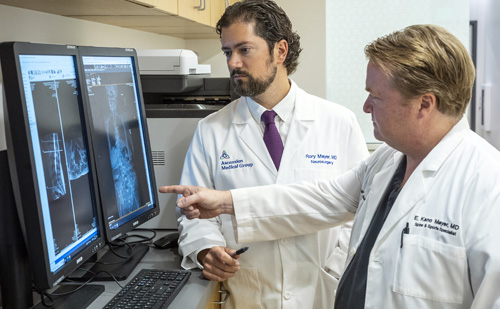Herniated Disc
 Overview of herniated disc / degenerative disc
Overview of herniated disc / degenerative disc
The spine is composed of many vertebrae stacked on top of each other. Between these bones are discs, which act as shock absorbers. The shock-absorbing discs resemble jelly donuts, each having a jelly-like center. As we age, the discs naturally become less flexible and more brittle. Normal disc degeneration which naturally occurs with old age, can also cause pain.
Discs can herniate in any direction — forward, centrally or, most commonly, backward and sideways in the direction of the spinal nerves.
Herniated discs account for a small percentage of back pain.
While herniated discs are often referred to as “slipped discs,” this really isn’t accurate because discs don’t ever slip out of position. They are actually attached by connective tissue to vertebrae above and below. A disc herniation can be “contained” or “uncontained.” With a bulge, for example, the jelly center remains within the disc wall. "Uncontained" means the jelly center has broken through the annulus wall but stays connected to the nucleus pulposus. Or the herniation can be “sequestered,” when it breaks free from the nucleus and travels away from the disc.
A bulging disc forms when the wall of the disc is deformed but not necessarily herniated. The nucleus is still contained in the wall. You never need surgery to treat a bulging disc.
Causes
In the event of a fall or heavy strain from lifting, discs can rupture, causing the nucleus to break through the wall of the disc and place pressure on the nerves that branch out from the spinal cord. This results in a herniated disc, accompanied by back or neck pain. For example, sitting down for a while, then lifting a heavy object, can cause a disc to herniate.
Symptoms
Sometimes, people mistake excruciating pain for a herniated disc, when the pain might actually be the signal of a muscle strain. Because the nerve roots act as telegraph lines to other parts of the body, a common complication of disc herniation is that it can cause pain that is felt in other parts of the body. In fact, leg pain below the knee is a common herniated disc symptom. This radiating pain is called radicular pain or radiculopathy. Often, back pain without leg pain can be a result of partial herniation of the disc or an internal disc disruption.
Treatment
Nonsurgical treatment methods are always the best option to try first. Non-surgical treatment options for herniated or degenerative discs include spine therapy and spinal injections that can relieve inflammation that is causing pressure on the nerve root coming off the spinal cord. However, if non-surgical treatment options fail to work, surgery may be needed to remove the herniated disc. This can as simple as a laminectomy or discectomy that removes the part of the disc that herniated, or it can involve a spinal fusion that inserts a piece of bone in the disc space where the herniated disc was removed. The alternative to a spinal fusion is artificial disc replacement which preserves the natural motion of the neck or back.
